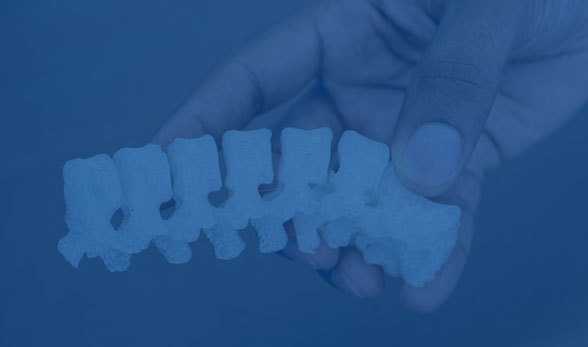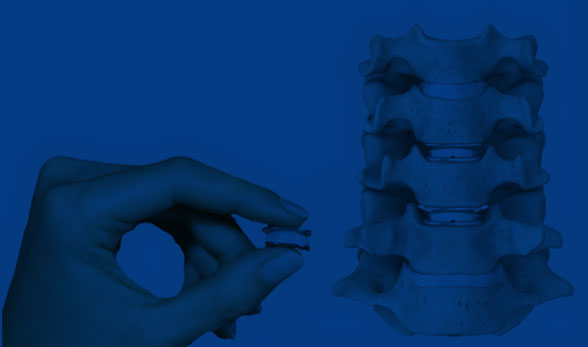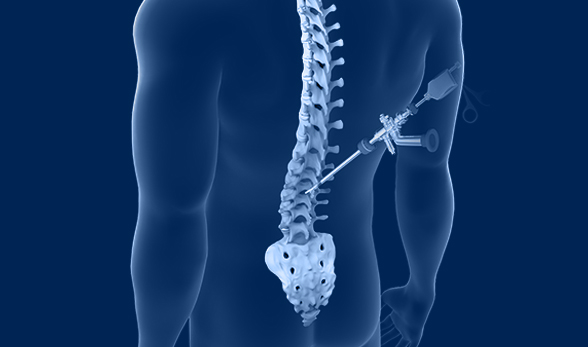Patient Specific Spinal 3D Printing
Patient Specific Spinal 3D Printing
If you are experiencing chronic back or leg pain that is unresponsive to conservative treatments, then you may be a candidate for minimally invasive spine surgery in conjunction with a 3D printed spinal implant.
Spinal fusion is a procedure that aims to join two or more vertebrae in the spine with the use of a spinal implant, made either out of titanium or plastic. Along with bone graft, these items will help fuse your spine to minimize motion and provide stability.
Spinal 3D-printing of customized spinal implants is a cutting-edge technique that offers improved outcomes for spinal fusion patients.
Spinal 3D-printing refers to a process where a 3D object is created from a digital design through successive layering of material under computer control, so called ‘additive manufacturing’.
Having gained much interest in recent years, 3D printing has found applications in many surgical and medical fields. Custom 3D printing of implants for spinal surgery has a potential to improve patient outcomes and results from surgery. 3D-printed implants have a special design and can be custom printed to match your individual needs. Each implant is 3D-printed in multiple shapes and sizes which are matched to the patient during surgery. This allows the implant to be custom-fit to your individual anatomy. The surgical instruments used to perform the procedure can also be printed to match your body’s needs.
Frequently asked Questions
Who is eligible to receive a 3D-printed spinal implant?
Most patients, except those with allergy or reactions to the metal, are eligible to receive 3D-printed implants. The technology can be particularly helpful in severe or complex cases that require multiple levels of fusion or higher fusion rates. Dr Webb can discuss at your visit whether a 3D-printed implant may be an option for your spinal fusion procedure.
Why should you consider 3D-printed spinal implants?
A major goal of a spinal implant design is to both help reestablish the spine’s proper anatomy and to help it fuse in that position. 3D printing can help achieve both of these goals. By creating a wide variety of heights, angles, and depths, the number of different shapes and sizes for implants is endless. This allows surgeons to use more patient-specific implants to achieve clinical success through ideal anatomic restoration. In most circumstances, the huge number of implant options that are on the market is all that is needed for a patient. However, there are situations where having a true patient-specific implant is needed such as when a patient has aberrant or not commonly sized anatomy.
What are the benefits of 3D spinal implants?
Complex spinal deformity, tumors, trauma, or infection frequently result in significant bony distortion and thus a normal implant off the shelf is not usually sufficient to fill this void. 3D printing technology allows a truly ideal and patient specific implant to be created to the individual’s circumstance.
In addition, the spinal Implants can be 3D printed in ways that allow for bony fusion. Certain metals, such as titanium, are ideal to achieve bony union. In general, an implant needs to roughly mimic the properties of bone in order to heal and fuse fully. If the implant is too stiff and rigid, it can indent and settle into bone, thereby losing the spacing and postural correction that was needed to achieve clinical success. If it is too soft, it simply doesn’t support the weight and can break. 3D printing can be utilized to create the ideal property match to minimize both of these potential catastrophic failures.
Lastly, 3D printing allows for the creation of the ideal surface on the implant which will allow fusion. The smaller the pores of an implant on the surface, the more surface area that bone can form onto. 3D printing allows for these microscopic roughened surfaces to be created, therefore increasing fusion rates.
References
Wallace N, Schaffer NE, Aleem IS, Patel R. 3D-printed Patient-specific Spine Implants: A Systematic Review. Clin Spine Surg. 2020 Jun 16. doi: 10.1097/BSD.0000000000001026. Epub ahead of print. PMID: 32554986.
Burnard JL, Parr WCH, Choy WJ, Walsh WR, Mobbs RJ. 3D-printed spine surgery implants: a systematic review of the efficacy and clinical safety profile of patient-specific and off-the-shelf devices. Eur Spine J. 2020 Jun;29(6):1248-1260. doi: 10.1007/s00586-019-06236-2. Epub 2019 Dec 3. Erratum in: Eur Spine J. 2020 May 26;: PMID: 31797140.
Wilcox B, Mobbs RJ, Wu AM, Phan K. Systematic review of 3D printing in spinal surgery: the current state of play. J Spine Surg. 2017 Sep;3(3):433-443. doi: 10.21037/jss.2017.09.01. PMID: 29057355; PMCID: PMC5637198.
Hsu MR, Haleem MS, Hsu W. 3D Printing Applications in Minimally Invasive Spine Surgery. Minim Invasive Surg. 2018 Apr 1;2018:4760769. doi: 10.1155/2018/4760769. PMID: 29805806; PMCID: PMC5899854.




